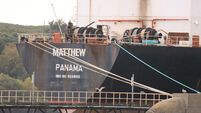'A huge step forward': Group of galaxies and ‘baby stars’ among new images released by Nasa

NASA’s James Webb Space Telescope reveals emerging stellar nurseries and individual stars in the Carina Nebula that were previously obscured. Picture: NASA, ESA, CSA, and STScI
The images released by Nasa today, taken of our distant universe by the James Webb Space Telescope have been described as "a huge step forward" for science.
The space agency unveiled its five initial images from the telescope, the largest and most powerful orbital observatory.
The first batch of full-colour, high-resolution pictures, which took weeks to render from raw telescope data, were selected by NASA to provide compelling early images from Webb's major areas of inquiry and a preview of science missions ahead.

Dr Niall Smith, head of Blackrock Castle Observatory in Cork said the images are truly astonishing and will teach us a huge amount about the origins of our universe and even life on Earth.
"It's like one of those days when you say 'Where were you, when...?' and this is where were you were when we saw the deepest image actually that humanity has ever seen," he said.
"The images go from examples of the very early universe through to galaxies that are colliding right now, going on as we speak, and then into stars that are like our sun.
"We're seeing structures in there that we've never seen before. So we didn't really know how this works. So that's amazing."
The telescope lifted off on an Ariane 5 rocket from Europe’s Spaceport in French Guiana on Christmas Day last year on its mission to unlock the secrets of the universe.
The first image, showing a deep field cluster of distant galaxies, was released on Monday after being shown to US President Joe Biden.

Among the four other images released on Tuesday are two enormous clouds of gas and dust blasted into space by stellar explosions to form incubators for new stars - the Carina Nebula and the Southern Ring Nebula, each thousands of light-years away from Earth.
The debut collection includes another galaxy cluster known as Stephan's Quintet, which was first discovered in 1877 and encompasses several galaxies described by NASA as "locked in a cosmic dance of repeated close encounters."
One of the discoveries that Dr Smith was most excited about was the discovery of water vapours in clouds on the WASP-96 b exoplanet.
"It's the first time that we really had absolute clear evidence of water in an atmosphere," he explained.
"And we know one thing about life on Earth is you can have life without air, but you can't have life without water... and what Webb has shown us with the spectrum of the WASP planet is that there is water definitively in the atmospheres of other planets.
He added: "It doesn't mean there's life there, but my goodness that's really exciting that we now know."

Dr Smith said that while this is very early days, when the images are observed and analysed they will show "good science".
"In a way it's pretty pictures at the moment, but what we can definitely see is finer structures than we've ever seen before."
"It's kind of really useful for us to have a good sense of how the how the universe began."
Dr Smith added: "So why it's important is it starts to help us understand how and when the earliest stars formed, because all of us ultimately comes from the stars are all the elements in our bodies come from stars.
"It's kind of really useful for us to have a good sense of how the how the universe began."
Meanwhile, the administrator of Nasa, said they are “just getting started” with new discoveries in the universe.
Bill Nelson said the telescope represented “the best of Nasa”.
He said: “It maintains our ability to pull us forward for science, for risk-taking, for inspiration and we don’t want to ever stop exploring the heavens nor stop daring to take another step forward for humanity.
“In the words of the famous Carl Sagan, ‘Somewhere, something incredible is waiting to be known’. I think those words are becoming a reality.”
Jane Rigby, Webb operations specialist, said: “The amazing thing with Webb is the speed with which we can churn out discoveries.”












